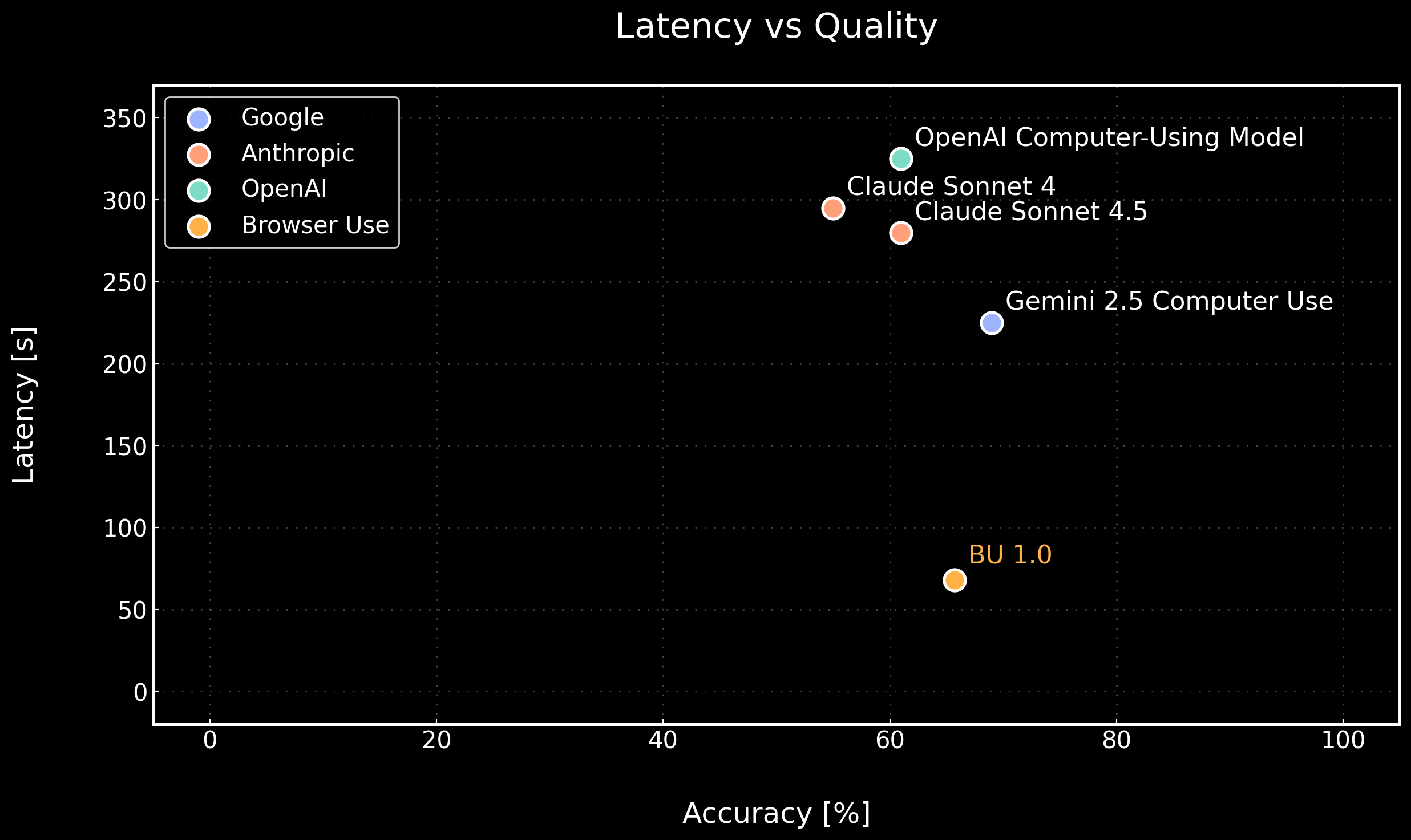Speed Matters: How Browser Use Achieves the Fastest Agent Execution
Matching state-of-the-art accuracy is table stakes. We built BU 1.0 to be the fastest browser agent while maintaining the same performance.
BU 1.0 achieves 65.7% accuracy on OnlineMind2Web — matching Gemini 2.5 Computer Use and outperforming all the other models. We recently released our LLM gateway that makes this possible.

But accuracy is table stakes. People want their agents to work at least as fast as humans.
Evaluation Challenges
Before diving into performance, a quick note on methodology: Standard screenshot-based evaluation pipelines like OnlineMind2Web's judge don't work for Browser Use. Why? Because BU 1.0 extracts the DOM into a text-based representation that the LLM can interact with. The agent can read content and interact with elements that aren't directly visible in screenshots.
Screenshot-based judges miss this entirely. So we adapted the judge to consider both the screenshot and the DOM state at each step. This gives a fair comparison to vision-based models while accurately capturing what DOM-based agents can actually do.
The Speed Advantage
In OnlineMind2Web, BU 1.0 agent completes tasks in 68 seconds on average. For context:
- Gemini 2.5 Computer Use: 225s
- Claude Sonnet 4.5: 285s
- Claude Sonnet 4: 295s
- OpenAI Computer-Using Model: 330s
We're significantly faster than other state-of-the-art models - taking on average 3 seconds per step with our strongest model.
Seeing is Believing
To put this in perspective, here's both agents executing the same task: "Find the most recent PR in github.com/browser-use/browser-use." BU 1.0 finishes in 15 seconds. Gemini 2.5 Computer Use takes 1 minute 15 seconds.
As you can see, we're getting into the regime where our agents are becoming as fast as human workers.
How We Built the Fastest Agent
Here we present some of the core optimizations drive this performance:
1. Making Use of the KV Cache
Unlike coding agents where state is "previous state + agent's changes," browser agents face a fundamental challenge: the browser state changes independently and must be re-observed at each step. This makes it difficult to treat browser interaction as "just a tool call."
We solved this by placing agent history before the browser state in our prompt structure. This lets us cache the entire conversation history while presenting fresh browser state to the agent. The result? Significant latency and cost reduction through KV cache hits without sacrificing state accuracy.
2. Screenshots Only When Needed
Most web navigation doesn't require vision. BU 1.0 navigates primarily using the DOM, only capturing screenshots when visual context is actually necessary.
The cost? Our experiments both with custom and closed-source multimodal models show that each screenshot adds ~0.8 seconds to LLM inference latency as the image encoder processes it. By making screenshots optional, we eliminate this overhead for the majority of steps and allow the model to view the page when needed.
3. Smart Text Extraction
Computer use models typically extract information by reading screenshots. This is expensive and limited—you can only see what fits on screen.
BU 1.0 has an extract tool that queries page's markdown directly from the DOM. When a page contains 20,000+ tokens of text, the agent doesn't dump everything into its context. Instead, it asks: "What's the price of this product?" or "When was this PR opened?" The extract tool runs a separate LLM call against the page markdown, retrieves only the relevant information, and returns it to the agent. This is clean, fast, and context-efficient and proves to be extremely important for long-running tasks with >50 steps.
This is fundamentally more efficient than vision-based information retrieval. The agent gets exactly what it needs without visual encoding overhead or context bloat.
4. Minimize Output Tokens
We measured token costs on our infrastructure with custom LLMs we trained for Browser Use:
- 1,000 input tokens: 29.1ms
- 10 output tokens: 62.6ms
Output tokens cost ~215x more time than input tokens per unit time.
To minimize output token usage, we designed our action space to be extremely concise. Action names and parameters are terse enough that most actions can be expressed in 10-15 tokens. Less output = faster execution.
Speed matters. BU 1.0 delivers SOTA accuracy at a fraction of the latency.
Get Started
To run blazing fast browser agents, update to Browser Use 0.8.0:
uv add browser-use==0.8.0Get your API key from cloud.browser-use.com and run:
import asyncio
from browser_use import Agent
from browser_use.llm import ChatBrowserUse
async def main():
agent = Agent(
task='Your task here',
llm=ChatBrowserUse(),
)
await agent.run()
asyncio.run(main())That's it. Set BROWSER_USE_API_KEY and you're running at 6x speed.
Pricing
| Token Type | Price per 1M tokens |
|---|---|
| Input tokens | $0.50 |
| Output tokens | $3.00 |
| Cached tokens | $0.10 |
Browser Use Team
Author